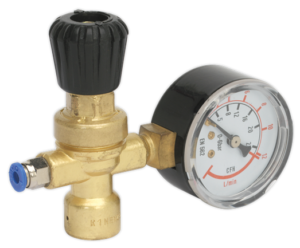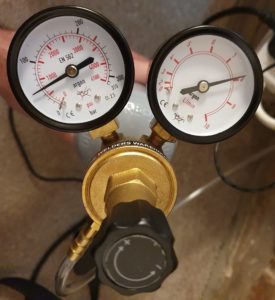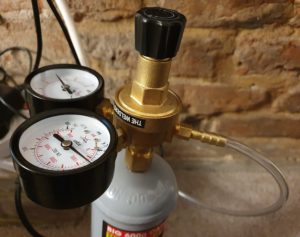The pressure inside any liquid CO2 tank is around 860 psi so the gas coming out of the tank needs to be controlled by a regulator to get the pressure down sufficiently that the gas comes out at a usable flow rate. MIG welding regulators reduce the pressure resulting in an adjustable flow rate in the range of 6 to 10 litres/minute. The flow rate is controlled by an adjustable control knob. Regulators can also feature a number of gauges to monitor the action.
Regulators with two gauges
Many regulators will come with two gauges; generally the one on the left monitors the gas pressure inside the source cylinder and the one on the right monitors either the flow or pressure output from the regulator. With liquid CO2 tanks, there’s not much to see for a long time on the source gauge since the cylinder pressure will always be 860 psi (around 50-60 bar) so long as there is any CO2 liquid left in the tank at all. At the end of the tank, the liquid will all be used up and only pressurised gas will remain and the dropping pressure on the source gauge can let you know that’s what’s happening where you might then consider switching out for a new CO2 tank.
Note the regulator gauges in the pictures say ‘argon’ rather than CO2. This is ok.

Regulators with one gauge
Regulators with only one gauge show the outlet pressure or flow only, but do not monitor the pressure remaining inside the source cylinder. This means you can potentially be surprised at the end of the CO2 tank supply, but in general I haven’t found that to be a major problem. Regulators with only one gauge can sometimes be of lesser quality than those with two gauges. I’ve tried both a single gauge and dual gauge regulator and I do think the one with two gauges gives better control.
Regulators without a gauge
You don’t actually need a gauge on the regulator; you can adjust the control knob and monitor what happens downstream. These are generally the least expensive regulators and one might worry those with the poorest quality as well. Not recommended.
Single vs. dual stage
Not to be confused with the number of gauges a regulator has, regulators can also be single or dual stage. Most regulators, even those with two gauges, are single stage. A dual stage regulator gives better control when the cylinder is running out of CO2 liquid. A dual stage regulator is about double the price of a single stage regulator and isn’t really necessary if you pay some attention when you anticipate the cylinder is about to run out. I haven’t ever found a dual stage regulator that will fit directly to a disposable CO2 tank – these are more for industrial level applications.
Different regulators for different gasses
Regulators are designed to work with specific gasses only and have threaded connections matched to input cylinders. CO2 and argon and argon/CO2 mixtures regulators are compatible with each other. On non-disposable cylinders the CO2 regulator has a female fitting whist an argon regulator uses as male fitting, but on disposable cylinders, CO2, argon and argon/CO2 mixes all use the same fitting connection. The Welders Warehouse has good information on the topic, and was where the Fireplace Aquarium dual-gauge regulator was sourced.

